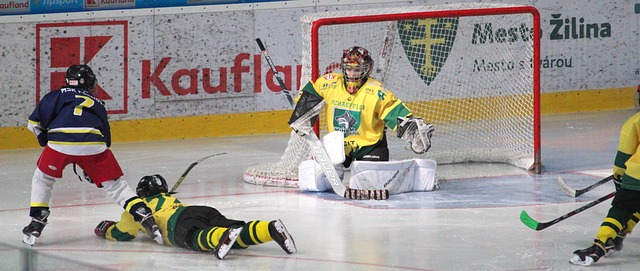Blocking the offensive onslaught of a determined hockey team isn’t just about having a solid goalie. It’s mastering the art of defense, with the neutral zone trap standing as a cornerstone strategy. This defensive technique not only disrupts opponents’ play but also turns the tides, creating offensive opportunities from seemingly insurmountable defensive positions.
The neutral zone trap isn’t about brute strength or flashy plays. It’s a ballet of positioning, patience, and strategy. Whether you’re a seasoned coach or a player eager to hone your skills, understanding and perfecting this technique is critical for dominating the ice.
In this post, we’ll explore essential drills to cultivate an impenetrable defense. Get ready to arm your team with the tactics they need to leave the opposition floundering and the scoreboard in your favor.
Understanding the Neutral Zone Trap in Hockey
The neutral zone trap is a classic defensive strategy that focuses on controlling the middle portion of the rink, stifling the opposing team’s offensive rush before it even begins. Originally made famous by the New Jersey Devils in the 1990s, it’s a tactic that requires sharp positioning and teamwork.
At its core, this strategy involves players aligning themselves across the neutral zone, ready to intercept passes and limit speed through the center ice. By “trapping” the opponent, it forces turnovers and creates frustrating obstacles, often leading to regaining control of the puck.
Each player’s role is crucial. Defensemen and forwards must work in unison to close passing lanes and pressure puck carriers into making mistakes. It’s a game of anticipation, with the ultimate aim of breaking the rhythm of the opposing team while setting up counter-attacks.
Precision and cooperation are key. The neutral zone trap is not just about stopping the opposition but turning defense into attack. When executed effectively, it can be a game-changer, keeping the opposing team’s strategy in check and pushing them back on their heels.
Key Defensive Concepts for Mastering the Neutral Zone Trap
Mastering the neutral zone trap hinges on a few key defensive concepts that can transform your team into an unyielding force on the ice. The first is anticipation. Players need to read the game, predicting the opponent’s moves and positioning themselves to intercept or disrupt their advance.
Communication is equally crucial. Every player should constantly talk, alerting teammates about potential threats and ensuring a cohesive defensive front. This coordination not only solidifies your defense but also instills confidence throughout the team.
Patience cannot be overstated. Rushing into plays can break the trap, giving opponents the opportunity they need. Disciplined patience helps maintain structure, forcing the other team into errors and bad passes as they try to navigate around your well-positioned defense.
Lastly, agility and quick reactions are essential. As opponents strive to break through, the ability to swiftly adapt and shift positions while maintaining formation can make a decisive difference.
By focusing on anticipation, communication, patience, and adaptability, your team can fortify its defense with the neutral zone trap, making it a powerful weapon in your strategic arsenal.
Drills for Improving Defensive Positioning and Team Coordination
Honing defensive positioning and team coordination through specific drills is crucial in mastering the neutral zone trap. Begin with the Neutral Zone Four-on-Four Drill. This drill reinforces positioning as players practice maintaining formation while reacting to the opponent’s movement through the neutral zone.
For this drill, divide players into two teams of four. The defending team arranges themselves across the neutral zone while the attacking team attempts to break through. Focus on maintaining the trap formation and communicating effectively to simulate game conditions.
Another effective exercise is the Three-Lane Passing Drill. This drill emphasizes passing lanes, helping players grasp the importance of cutting off and disrupting opponent passes. Split players across three imaginary lanes in the neutral zone and conduct passing exercises that reinforce anticipation and quick decision-making.
These drills should encourage communication and synchronization among team members. Adaptability is fostered when players repeatedly face different scenarios, learning to adjust their position as needed.
By investing in these drills, your team will develop the essential skills required for a robust neutral zone trap, ultimately strengthening your defensive strategy and frustrating skilled offensive lines.

Crafting Effective Strategies to Neutralize Offensive Attacks
Neutralizing offensive threats involves crafting strategies that not only anticipate but also disarm the opposing team’s plays. A versatile strategy is to implement a fluid positioning system. Allow defenders to adapt quickly to the opponent’s tactics rather than rigidly sticking to initial formations.
Another critical strategy is pressure application. Encourage players to apply pressure on the puck carrier without overcommitting, forcing errors or rushed plays. This balance between aggressiveness and caution can lead to turnovers and enable counter-attacks.
Implement a staggered formation where players maintain spacing to cover more ice and disrupt passing lanes. This formation can deter speedy breaks and funnel opponents toward the perimeter where they are less effective.
Lastly, emphasize the importance of reading the game. Encourage players to keep their heads up, scanning the ice for potential threats and allies ready for a counter-play. This awareness helps ensure quick transitions from defense to offense, capitalizing on opponents’ weaknesses.
These strategies help create a cohesive approach to defense that not only prevents successful offensive maneuvers but also primes your team to seize opportunities, turning the defensive play into an attack.
The Bottom Line: Executing the Neutral Zone Trap with Precision
In the fast-paced world of hockey, the neutral zone trap stands as a critical defensive tactic that separates skilled teams from their rivals. By mastering this strategy, your team can effectively stymie opposing offenses while setting the stage for counter-attacks.
Executing the neutral zone trap with precision requires dedication to several key elements. First and foremost, the importance of communication and synchronization cannot be overstated. A team that speaks the same language on ice harnesses power unseen by individual brilliance alone.
Drills that sharpen defensive positioning and enhance coordination are imperative. It’s these refined skills that enable a team to glide seamlessly across the rink, intercepting plays and confounding opponents at every turn. Whether through neutral zone four-on-four simulations or inventive passing lane exercises, practice lays the groundwork for success.
Besides this, strategy plays a defining role. The blend of flexibility in positioning, assertive yet cautious pressure, and the capacity to read the game dynamically crafts a formidable defense. Your team should be ready to make split-second decisions backed by rigorous training and a clear understanding of every player’s role.
Ultimately, the execution of the neutral zone trap is an art that demands both disciplined practice and agile thinking. For those willing to invest in this craft, the reward is a resilient and tactical defense capable of turning the tide of any game.
With careful attention to these principles, your team will not only shut down the opposition but seize opportunity that lies within defensive mastery, transforming challenges into victories on the ice.

